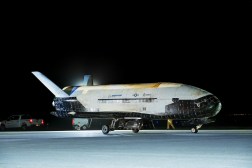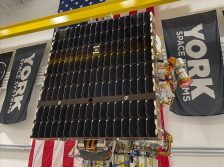Pentagon launches secretive X-37B space plane for new mission

The Space Force launched the secretive X-37B orbital test vehicle Thursday night, kickstarting the space plane’s eighth mission.
For the effort, dubbed OTV-8, the Boeing-made spacecraft is expected to conduct a wide range of tests and experiments focused on laser communication tech and quantum inertial sensors, according to officials.
Thursday night’s launch was a success, according to Space Systems Command.
“U.S. Space Force’s National Security Space Launch (NSSL) program and SpaceX’s Falcon 9 rocket launched the USSF-36 mission into orbit Aug. 21 from historic Launch Complex (LC)-39A at NASA’s Kennedy Space Center, Florida,” the command said in a press release early Friday. “The mission, carrying the U.S. Air Force X-37B Orbital Test Vehicle (OTV) spacecraft, lifted off on schedule at 11:50 p.m. EST (8:50 p.m. PST).”
Boeing stated in a press release Friday morning that the “vehicle is healthy on orbit and proceeding with standard checkout.”
“Our role is to make sure the spaceplane is the most reliable testbed it can be,” Michelle Parker, vice president of Boeing Space Mission Systems, said in a statement. “None of this happens without teamwork. Launch is the starting line for this mission, but the work that follows –the quiet, methodical work on orbit, analysis and eventual return is where progress is earned.”
First launched in 2010, the X-37B has conducted seven missions in space designed to test novel technologies under development by the Pentagon and NASA. The reusable spacecraft is designed for years-long flights before it returns to Earth, where it can be repurposed for future missions.
“Having a returnable space platform allows us to learn faster,” Col. Brian Chatman, installation commander for Space Launch Delta 45, said in a statement included in the Boeing press release. “The data we gather from the X-37B speeds decisions, hardens our architectures, and helps Guardians stay connected and on course even in contested environments. This is how we move from promising ideas to fieldable capability at pace.”
The Air Force Research Laboratory and Defense Innovation Unit will also partner with the service and NASA for the upcoming experiments, according to the Space Force.
During the space plane’s seventh mission, which started in 2023 and wrapped up earlier this year, the Pentagon and NASA experimented with operations in new orbital regimes, space domain awareness capabilities and effects of radiation on orbit.
According to the Space Force, the X-37B’s eighth mission will test “high-bandwidth inter-satellite laser communications” — a capability that allows sats to transmit data between one another or to ground stations, enabling higher bandwidth and faster data transmission than traditional radio frequency communications.
Laser links are a critical component for several Space Force development programs, such as the Space Development Agency’s mega-constellation known as the Proliferated Warfighter Space Architecture (PWSA).
The space plane will also experiment with augmenting PNT capabilities in GPS-denied environments by demonstrating the highest-performing quantum inertial sensor ever in space, a Boeing press release noted.
“Whether navigating beyond Earth-based orbits in cis-lunar space or operating in GPS-denied environments, quantum inertial sensing allows for robust navigation capabilities where GPS navigation is not possible,” Space Delta 9 Commander Col. Ramsey Hom said in a statement. “Ultimately, this technology contributes significantly to our thrust within the Fifth Space Operations Squadron and across the Space Force guaranteeing movement and maneuverability even in GPS-denied environments.”
Updated on Aug. 22, 2025, at 10:05 AM: This story has been updated to include information from a Boeing press release.






